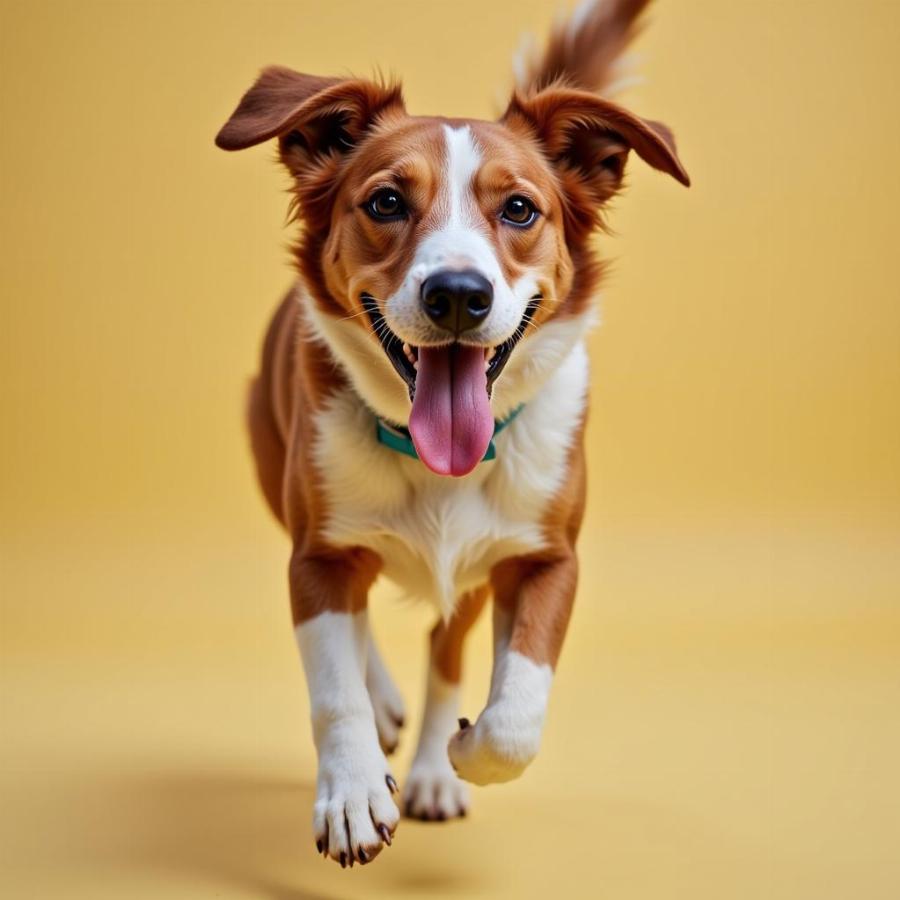Dogs are masters of nonverbal communication, expressing themselves through a symphony of barks, wags, and, of course, those hilarious and sometimes baffling behaviors we often interpret as “dog signs.” Ever wonder what your furry friend is really trying to tell you? Let’s dive into the world of humorous dog signs and unlock the secrets behind your pup’s antics.
The Case of the Zoomies: Why Does My Dog Run Around Like Crazy?
We’ve all seen it – that sudden burst of energy that sends your dog sprinting around the house like a furry tornado. This phenomenon, affectionately dubbed the “zoomies,” is a classic example of humorous dog signs. While it might seem random, those frantic laps are often your dog’s way of releasing pent-up energy, especially common in puppies and high-energy breeds.
 Dog Running With Zoomies
Dog Running With Zoomies
Think of it like this: your dog might have been holding it together all day, being a well-behaved companion, but inside, they’re a coiled spring of pure canine enthusiasm. The zoomies are simply their way of letting loose and embracing their inner goofball.
Butt Wiggles and Playful Bows: The Universal Language of Dog Fun
Some humorous dog signs transcend words and even species. A wagging tail is a pretty clear indicator of a happy pup, but what about those full-body wiggles, complete with enthusiastic butt shakes and playful bows? Consider it an invitation to join the party!
These goofy displays are your dog’s way of saying, “Let’s have some fun!” They’re often accompanied by playful barks, nips, and invitations to chase. So next time your dog breaks out their best dance moves, grab a toy and get ready for some tail-wagging good time.
The Guilty Look: Master Manipulators or Misunderstood?
Ah, the infamous “guilty look” – those puppy-dog eyes and slumped shoulders that seem to scream, “I’m sorry I ate your shoe.” While it’s tempting to believe our dogs are capable of feeling remorse, experts suggest that what we perceive as guilt is likely a response to our own body language and tone of voice.
Dogs are incredibly perceptive to our emotions. When we come home to a chewed-up masterpiece and greet our furry culprit with a disapproving tone, they pick up on our displeasure and react accordingly.
Dr. Emily Parker, a certified applied animal behaviorist, explains, “Dogs are incredibly skilled at reading our body language and vocal cues. When they sense our disapproval, they often display submissive behaviors that we interpret as guilt, even if they don’t fully understand why we’re upset.”
Decoding the Quirks: Building a Stronger Bond Through Humor
Understanding your dog’s unique communication style, even the humorous signs, is key to strengthening your bond and building a relationship based on trust and understanding. Pay attention to your dog’s body language, facial expressions, and those adorable, sometimes perplexing, behaviors.
Remember, every dog is an individual, and what’s considered a “humorous” sign for one dog might be a sign of something else entirely for another. If you’re ever unsure about your dog’s behavior, it’s always best to consult with a veterinarian or a certified dog trainer.
Need help deciphering your dog’s unique language? Contact us at [email protected] for expert advice and personalized guidance. At Beaut Dogs, we’re passionate about helping you navigate the wonderful world of dog ownership.
For more insights into dog behavior, check out these related articles:
By embracing the humor in our furry companions’ antics, we open ourselves up to a deeper understanding of their world and strengthen the bond we share. After all, laughter is the best medicine, especially when it comes with a wagging tail and a wet nose nudge.